Wreck Dives of Chuuk (Truk) Lagoon
Wreck information courtesy
of
Blue Lagoon Dive Resort
Chuuk Island, FSM
Chuuk (Truk) Lagoon has over 60 wrecks, many only recently discovered. Ships, aircraft, battle tanks, vehicles, and a large assortment of World War II armament. Some of them took part in the attack on Pearl Harbor and Midway Island operation. Listed below are a selection from the most popular wrecks of Chuuk (Truk) Lagoon.
Kimiuo Aisek opened the Blue Lagoon Dive Shop on November 13, 1973 and it was the first dive operation on Chuuk. Blue Lagoon Resort and Blue Lagoon Dive Shop

SAN FRANCISCO MARU
Depth: Superstructure 150 feet /45.7 meters, bottom 205 feet / 63 meters
The San Francisco Maru was built in 1919. When World War II began, she was taken out of semi-retirement by the Japanese Navy and pressed into service carrying military cargo.
One of the San Francisco's most striking features are the three Japanese Type-95 light tanks that still remain on her deck. The Type-95 tank was manned by a crew of three. It possessed ½” armor. It weighed 7.5 tons and carried one 37 MM main gun and 2-7MM machine guns. It was powered by a six-cylinder air cooled diesel engine which could propel the tank up to 30 mph. During "Operation Hailstone", the San Francisco Maru was damaged by dive bombers and photos show her stern on fire before she finally sank. The San Francisco Maru was discovered in 1972. The wreck sits upright. The cargo holds contain sea mines, torpedoes, bombs, artillery, aircraft engines, anti-tank and small arms munitions, and many other artifacts.
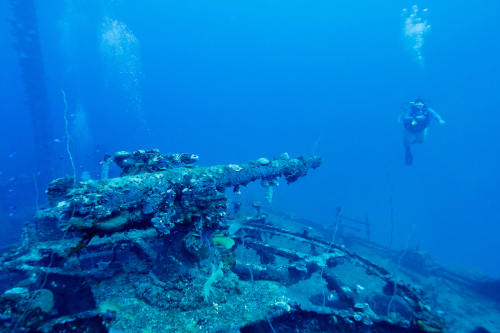
San Francisco Maru
HEIAN MARU
Depth: Hull 40 feet / 12 meters, bottom 120 feet / 36 meters
The Heian Maru was built in 1930 as a large passenger cargo liner. Her maiden voyage was from Hong Kong to Seattle. While on a routine voyage in August 1941, she was abruptly recalled to Japan. Upon her return, the Japanese Navy converted the ship for use as a submarine tender.
It is the largest ship in Truk Lagoon. The Heian Maru was sunk on the second day of "Operation Hailstone". A torpedo struck her amidships and because of damage already sustained during the earlier raids, the Heian Maru sank quickly. The Heian Maru lies on her port side. The cargo of the Heian Maru contains many of the deadly efficient Japanese Long Lance Torpedoes, as well as submarine periscopes. Many artifacts can be found throughout this wreck.
AIKOKU MARU
Depth: Superstructure 130 feet / 40 meters, bottom 210 feet / 64 meters
The Aikoku Maru functioned as a submarine tender, cargo and troop transport ship. On the day of the attack, she was carrying various high explosives in her forward holds including ammunition, aerial bombs, mines, and her own shells. A large anti-aircraft gun is located on top of the aft deckhouse. The explosion that destroyed the Aikoku Maru was so violent it also destroyed the attacking U.S. Navy aircraft.
AMAGISAN MARU
Depth: Superstructure 100 feet / 30 meters, bottom 200 feet / 61 meters
The Amagisan Maru was originally constructed as a cargo/passenger ship. The Japanese Navy acquired the ship in 1943 and used it as a special transport. In February 1942, she sustained damage during a torpedo attack by a U.S. Navy sub. During "Operation Hailstone" the Amagisan Maru was sunk by bombs and aerial torpedo. Among her most interesting features are the pilot house, a bow gun, torpedo holes, staff cars, and on the sea floor, a tank truck. The Amagisan Maru was discovered in 1973.
HANAKAWA MARU
Depth: Superstructure 50 feet / 15 meters, bottom 110 feet / 34 meters
The Hanakawa Maru was built in 1943 as a special transport for the Japanese Navy. The ship was sunk on the second day of "Operation Hailstone". Her cargo contained aviation fuel that ignited during the attack. The ship was sunk by a torpedo hit on her starboard bow. She now lies a few hundred yards from the shore of Tol Island. The Hanakawa Maru rests upright. A large variety of coral and marine growth is quite abundant on this wreck.
DAI NA HINO MARU
Depth: Superstructure 3 feet / 1 meter, Bottom 70 feet / 21 meters
Years ago when you saw a poster for Truk Lagoon, this small freighter was the featured wreck. The bow gun was the most recognizable part of the wreck. Snorkelers can easily glide under the gun. The ship was struck by two large bombs and sent to the bottom.
FUJIKAWA MARU
Depth: Superstructure 30 feet / 9 meters, bottom 112 feet / 34 meters
The Fujikawa Maru was built in 1938 by the Mitsubishi Company as a passenger and cargo carrier. The Japanese Navy took possession of her in December 1940 and converted the ship to an aircraft ferry. The conversion included a compliment of six-inch guns on her bow and stern. These guns were remnants from the Russo-Japanese War. Just prior to "Operation Hailstone," Fujikawa Maru arrived in Truk and off-loaded thirty "Jill" B5N2 bombers onto Eten Airfield. Since these aircraft had been disassembled for shipment, they were unable to help defend Truk and were destroyed on the ground. The cargo hold still contain Zero fighters. Today the Fujikawa Maru has an abundance of colorful soft coral and large formations of hard corals. It is regarded by many divers as the most popular wreck of Truk Lagoon.
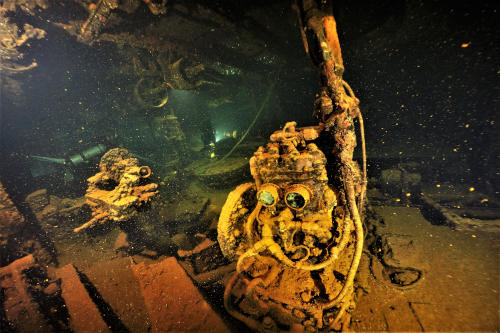
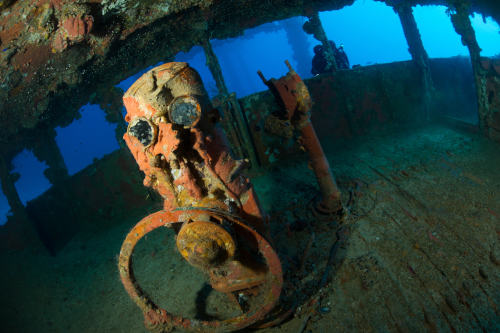
Fujikawa Maru
FUJISAN MARU
Depth: Superstructure 120 feet / 37 meters, Bottom 170 feet / 52 meters
Like many of the wrecks of Truk Lagoon, the Fujisan Maru has historic significance. Built in 1931, her pre-war duties consisted of carrying crude oil from the US to Japan. In late 1941 The Japanese Navy acquired the ship and utilized it as a "Fleet Oiler." She participated in the Battle of Midway as part of the Aleutian diversionary task group and, due to her fast speed, was also part of the "Tokyo Express." Fujisan carried a cargo of 1900 troops in a desperate attempt to reinforce New Guinea. A B-17 managed to hit her with a bomb in December 1943, but she was back in service by early 1944. During "Operation Hailstone", the Fujisan Maru was one of the few vessels underway. She was attacked by aircraft and struck with 1000 lbs. delayed action armor piercing bombs. Her engine order telegraph still signals for FULL AHEAD. Machine guns with ammunition scattered about, testify to her futile attempts at defense.
GOSEI MARU
Depth: Hull 8 feet 2.4 meters, bottom 100 feet / 31 meters
The Gosei Maru was built in 1937 as a coastal freighter. The Japanese Navy acquired the ship and utilized it as a supply ship for Sixth Fleet submarines. She carried torpedoes and depth charges. In 1976 many of her torpedoes were destroyed to eliminate possibility of detonation. During "Operation Hailstone," Gosei Maru was sunk by a torpedo. She now lies on a slope. The depth ranges from 8 feet at the stern to 100 feet at the bow. The rudder and propeller of the Gosei Maru make for excellent photographic subjects.
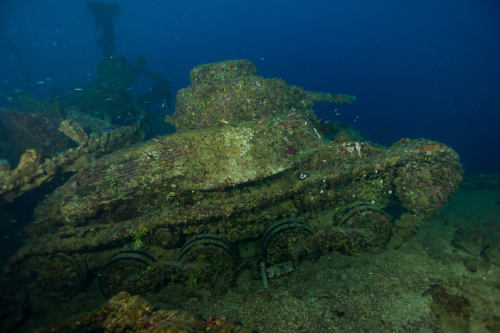

Gosei Maru
HOKI MARU
Depth: Superstructure 110 feet / 33 meters, bottom 175 feet / 53 meters
The Hoki Maru was built in 1921. Originally christened the British-New Zealand ship M/V Hauraki, under the ownership of the Union Steamship Corporation of New Zealand. When hostilities began on December 7, 1941, Hauraki was on a run from Fremantle, Australia to Colombo, Sri Lanka. The ship was captured by Imperial Japan's Aikoku and Hokoku Maru (also sunk at Truk). The crew of the M/V Hauraki were interned in the Ofuna Work Camp until their liberation in 1945. The Japanese renamed the ship the Hoki Maru on December 31, 1942 and designated her as a special transport for war material. In late January 1944, she left Yokohama with coal, supplies and personnel for Truk. Much of the construction equipment in her holds is thought to have been captured in the Philippine Islands. The wreck of the Hoki Maru sits upright with a slight list to port. The cargo includes Caterpillar tractors, stack bed trucks, tow tractor, dump trucks, steam roller, and other construction vehicles. Other artifacts include aircraft engines and propellers, ship propellers, bombs and their fuses, and many other items.
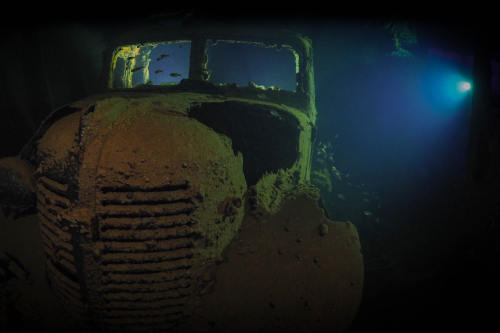
Hoki Maru